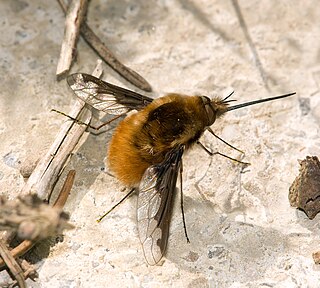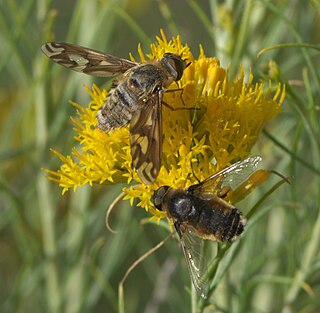
The Bombyliidae are a family of flies, commonly known as bee flies. Some are colloquially known as bomber flies. Adults generally feed on nectar and pollen, some being important pollinators. Larvae are mostly parasitoids of other insects.

Poecilanthrax willistonii, Williston's bee fly or sand dune bee fly, is a member of the Bombyliidae insect family. This family includes the bee flies, true flies that have developed Batesian mimicry characteristics to avoid predators. That is, they look like bees because that helps them avoid bee-wary predators, but they lack stingers.

Heterostylum robustum is a species of bee fly in the family Bombyliidae. It is found in southwestern Canada, most of the western United States, and Mexico. It is a bomber fly, parasitizing bees and wasps by launching its eggs into their nests. It is the principal parasite of the alkali bee Nomia melanderi, an important alfalfa pollinator across Washington, Oregon, Idaho, and Wyoming. Other hosts of the fly include solitary bees such as Nomia nevadensis bakeri, Dieunomia triangulifera, Calliopsis anthidia, Nomia scutellaris, and Halictus rubicundus.
Systoechus oreas is a species of bee fly in the family Bombyliidae. It is found in British Columbia, Canada and the western United States. Its larvae are predators of grasshopper eggs.
Anastoechus melanohalteralis is a species of bee fly in the family Bombyliidae. It is found in Alberta, Canada, and across the western and central United States. Its larvae are predators of grasshopper eggs.

Anastoechus is a genus of bee flies. There are at least 90 described species in Anastoechus.

Systoechus solitus is a species of bee fly in the family Bombyliidae. It is found in the southeastern United States from New Jersey to Florida and Louisiana. Its larvae are predators of grasshopper eggs.
Systoechus vulgaris, the grasshopper bee fly, is a species of bee fly in the family Bombyliidae. It is found in Canada and across most of the United States. Its larvae are predators of grasshopper eggs.

Anastoechus hessei is a species of bee fly in the family Bombyliidae. It is found in the southwestern United States from California to Texas. Its larvae are predators of grasshopper eggs.

Systoechus candidulus is a species of bee fly in the family Bombyliidae. It is found in Ontario, Canada, and across most of the United States. Its larvae are predators of grasshopper eggs.
Systropus angulatus is a species of bee fly in the family Bombyliidae. It is found in Texas.
Paracosmus edwardsii is a species of bee fly in the family Bombyliidae. It is known from California and Utah.
Lepidanthrax oribates is a species of bee fly in the family Bombyliidae. It is widespread in the western United States from California and Nevada north to British Columbia, Canada.
Paradiplocampta is a genus of bee flies in the family Bombyliidae. There is one described species in the genus Paradiplocampta, P. tabeti, known from California and Arizona.
Hemipenthes inops is a species of bee fly in the family Bombyliidae. It is found in the western United States. It is somewhat unusual compared to other members of the genus Hemipenthes in that its wings are mostly transparent.
Paracosmus insolens is a species of bee fly in the family Bombyliidae. It is known from California and Nevada.
Lepidanthrax arnaudi is a species of bee fly in the family Bombyliidae. It is found in California.

Dipalta serpentina is a species of bee fly in the family Bombyliidae. It is widespread in North America from British Columbia, Canada south and east through most of the United States to Florida, Mexico, Cuba, Guatemala, and Honduras. It is a parasitoid of antlion species such as Myrmeleon immaculatus.
Anastoechus leucothrix is a species of bee flies.
Hemipenthes edwardsii is a species of bee fly in the family Bombyliidae. It is found in the western United States and British Columbia, Canada.








